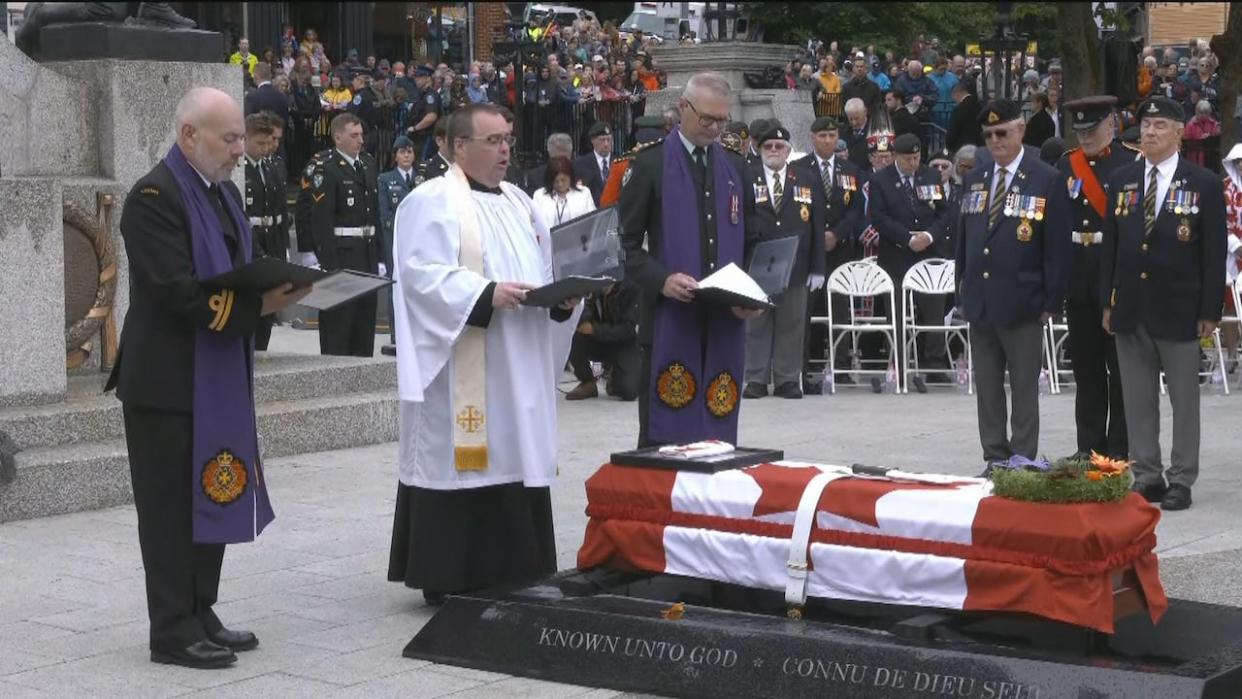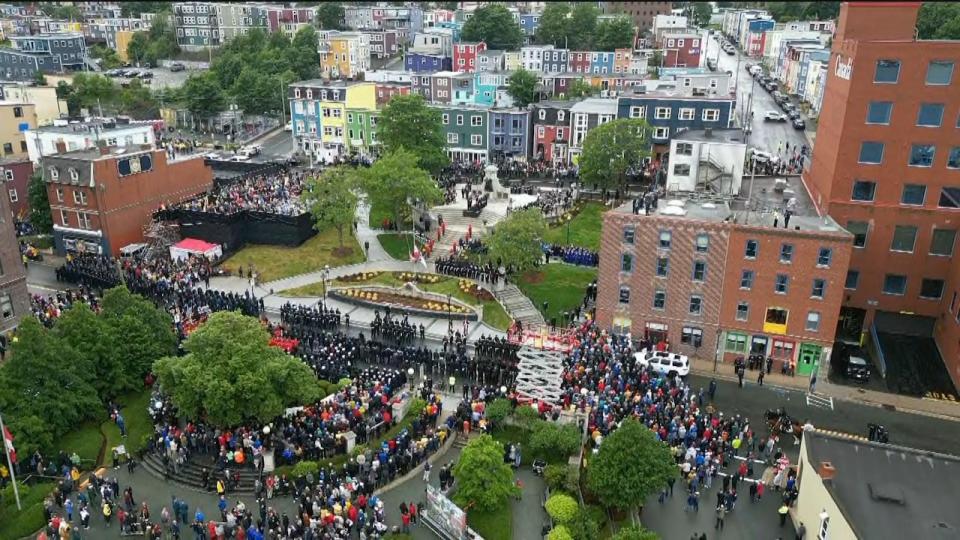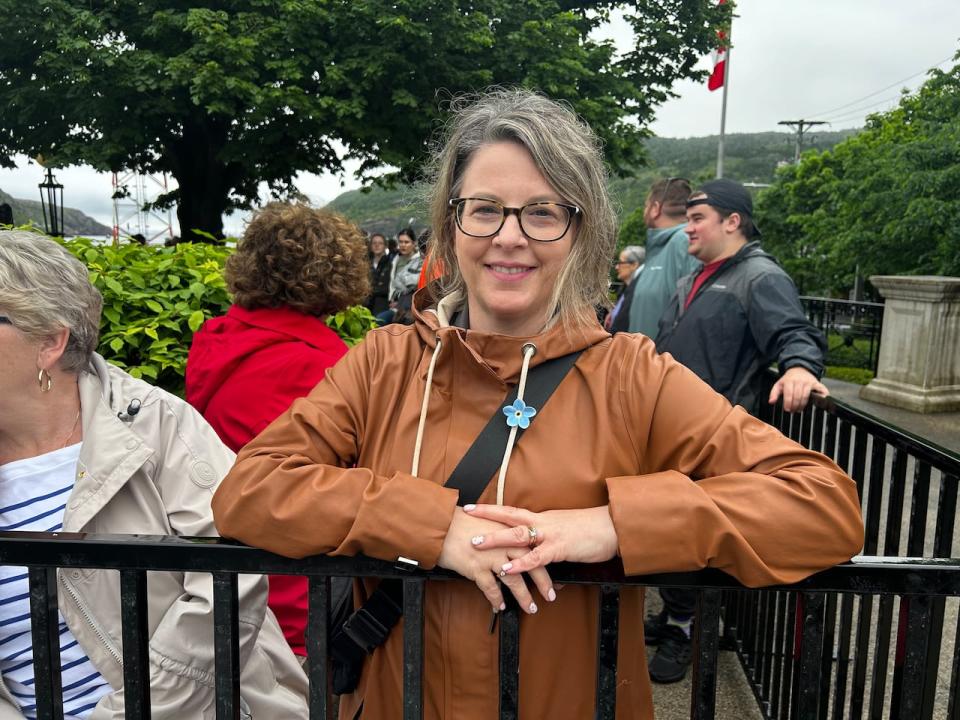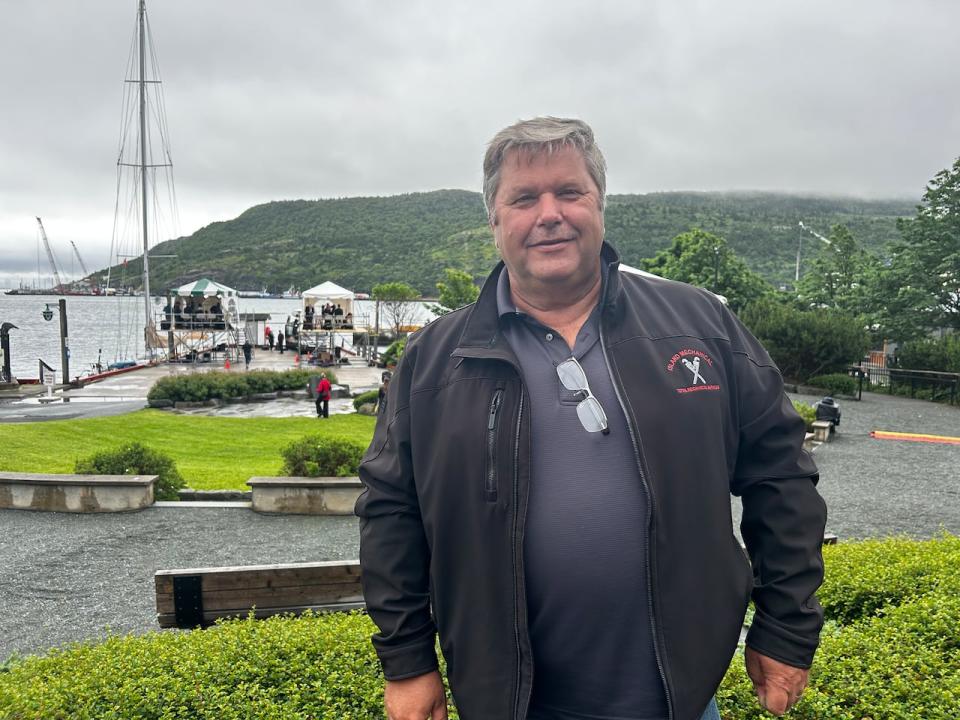Under grey skies and rain, N.L. entombs its Unknown Soldier in solemn ceremony at war memorial

Newfoundland's Unknown Soldier has been entombed at the National War Memorial following a solemn ceremony decades in the making in downtown St. John's.
The Unknown Soldier arrived at the stage in front of the National War Memorial and, accompanied by the sound of bagpipes, pallbearers took the casket from the hearse and made their way up the steps of the memorial.
"No one can have greater love than to lay down their life for their country. We gather today to bear witness to the end of a pilgrimage which has brought the earthly remains of this Newfoundlander and Labradorian from Europe to this, his final resting place, at this National War Memorial," said Canadian Armed Forces chaplain Lt.-Col. Shawn Samson.
Premier Andrew Furey was presented with the ensign flag, which the Unknown Soldier would have fought under, and also received the Canadian flag that had been draped over the casket.
After a rendition of the Ode to Newfoundland, the chaplain spoke a few more words, three volleys of gunfire rang out, and the pallbearers lowered into the tomb, followed by a fly-past by the Royal Canadian Air Force.
Newfoundland's Unknown Soldier brought home in moving ceremony:
Then 820 forget-me-not flowers were placed over the casket, representing the 820 men from Newfoundland who served but have no known grave.
The pallbearers then slowly placed the lid over the tomb and secured it.
The hearse, which was accompanied by a marching contingent of hundreds Canadian Armed Forces members, made its way down Water Street in downtown St. John's toward the war memorial, with Furey — the soldier's ceremonial next of kin — following on foot with his family.
Thousands of spectators are gathered at the memorial and along St. John's streets for the ceremony.

The procession from the staging area began at 10 a.m. NT with rifles firing a 19-gun salute — one volley firing every minute for 19 minutes — from the Queen's Battery on nearby Signal Hill, after the casket arrived in a hearse from Confederation Building, the seat of government for Newfoundland and Labrador, where the soldier had been lying in state since Friday.
Retired general Rick Hillier, former chief of defence staff, emphasized the significance of the Unknown Soldier returning to Newfoundland.
"We're burying today not a corpse from 108 years or 106 years ago, we're burying a young son from Newfoundland and Labrador today," Hillier, a Newfoundlander, told CBC News on Monday morning ahead of the ceremony.
With the Unknown Soldier entombed, the ceremony's focus turned toward Memorial Day.
July 1 has always been a sombre day in Newfoundland and Labrador. Marked for decades long before Newfoundland joined Confederation in 1949, the day serves as one of remembrance for soldiers killed or wounded in battle.
"We gather on July 1 to call to our remembrance, July 1, 1916, the day when the Newfoundland Regiment was almost wiped out," said Royal Canadian Legion Padre Ian Wishart.
He spoke about the sacrifice made by those who served and lives that were given to the country and the world.
"We give thanks for the freedom we enjoy. Freedom to think. Freedom to speak. Freedom to choose. And to make choices every day. We remember those who bought that freedom for us. Some at the cost of their lives. Some at the cost of great suffering."
Dignitaries and special guests, including Prime Minister Justin Canada, Gov. Gen. Mary Simon and Newfoundland and Labrador Lt.-Gov. Joan Marie Aylward, laid wreaths at the memorial.
"Today, we commemorate the end of a very long journey, one that began over a century ago when England beckoned and the brave men and women of our proud dominion answered the call," Furey told the assembled crowd.
He said those enlisting probably didn't think it would be the last time they would see their home again but for many of them it was. Many of their graves are inscribed with "Known Unto God," he noted.
"But we know them," said Furey, who added there are memorials and monuments across N.L. with their names.
Simon said they served with courage and distinction and their remains are still being found in battlefields in Europe.
"This Unknown Soldier represents all of those Newfoundlanders and Labradorians who fell in the First World War and whose remains were never identified," said the Governor General.
"Their selfless service will forever be honoured here at the Newfoundland National War Memorial."
When war was declared in summer of 1914, Trudeau said, thousands of Canadians and Newfoundlanders rushed to enlist and fought bravely but many didn't come back.
"We will remember them," said Trudeau.
He mused about the type of person the Unknown Soldier might have been, his family and aspirations for the future after the war.
"Whoever he was, he fought for our freedom, so that we could enjoy the simple things of life that bring us happiness. Today we brought him home," saud Trudeau.
Of the 780 members of the Royal Newfoundland Regiment who went on the offensive at Beaumont-Hamel in France on July 1, 1916 — the opening day of the Battle of the Somme — only 110 survived, and just 68 were available for roll call the following day.
The remains of Newfoundland's Unknown Soldier were repatriated from northern France on May 25.
This year's annual Memorial Day ceremony marks the centennial of the National War Memorial in downtown St. John's, unveiled by Field Marshal Douglas Haig in 1924.

"It's really important to be here to represent … all those people who fought in the war," said Jennifer Fleming, who said her great-great-grandfather was one of what's called the First Five Hundred, the group of soldiers who were first to enlist and go overseas in October 1914.
"Those brave men who went over and didn't come home. I think it's important that we're here for them," said Fleming.
"I think it's quite fitting for Newfoundland to be represented with the Unknown Soldier because so many of them didn't come back," said Walter Peddle, one of the people who arrived hours in advance to see the ceremony.
"This is pretty touching," said Dennis Goodyear, who described himself as a 30-year veteran.
"My grandfather served with the Royal Newfoundland Regiment and was wounded in World War I [and] was lucky enough to come back," he told CBC News. "As long as this young gentleman is home, that's the main thing. It's not me. It's him."
The refurbishment of the National War Memorial went on for months, with work focused on restoring statues to their original elegance.

CBC News has live Memorial Day coverage Monday from 9 a.m. NT (7:30 ET) to 12:30 p.m. Watch on CBC Television, visit cbc.ca/nl or watch CBC Gem.
Two offsite viewings are being held at The Rooms cultural complex and at the Sheraton Hotel.
Repatriation was just a dream a century ago
It's a moment that was a long time coming.
The repatriation of Newfoundland's Unknown Soldier started with Thomas Nangle had in 1920. Nangle, who had been the regiment's Roman Catholic padre, later served as Newfoundland's director of war graves registrations and enquiries, and as the country's representative on the Imperial War Grave Commission.
His wish didn't come to fruition — that is, until a century later, when 40-year navy veteran Frank Sullivan picked up the torch to finish the task. He has been there every step of the way, including being front and centre during the repatriation ceremony at Beaumont-Hamel in May.
Sullivan's great-uncle, Pte. Charles Canning, served with the regiment in France and was killed in 1918. He has no known grave.
The man chosen as the Unknown Soldier will remain unknown so that he can represent all Newfoundlanders who did not make it home from the First World War and have no known grave.
Download our free CBC News app to sign up for push alerts for CBC Newfoundland and Labrador. Click here to visit our landing page.


